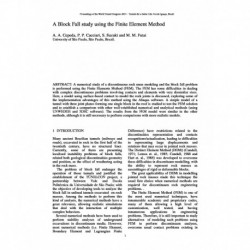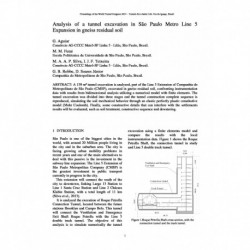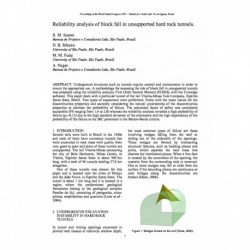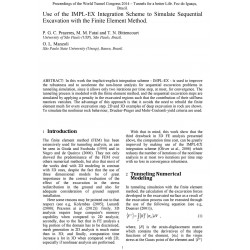No document
Search & filter
Search for a publication
Search & filter
List of products by author: M. M. Futai
-
A Block Fall study using the Finite Element Method
Abstract: A numerical study of a discontinuous rock mass modeling and the block fall problem is performed using the Finite Elements Method (FEM). The FEM has some difficulties in dealing with complex discontinuous problems involving contacts and elements with very dissimilar sizes. Here, a model using surface-based contact to model the rock joints is discussed, exploring some of the implementation...
0,00 € -
Analysis of a tunnel excavation in São Paulo Metro Line 5 Expansion in gneiss residual soil
Abstract: A 139 m² tunnel excavation is analyzed, part of the Line 5 Extension of Companhia do Metropolitano de São Paulo (CMSP), excavated in gneiss residual soil, confronting instrumentation data with results from bidimensional analysis utilizing a numerical model with finite elements. The tunnel excavation was divided into three stages and the tunnel construction complete sequence is reproduced,...
0,00 € -
Reliability analysis of block fall in unsupported hard rock tunnels
Abstract: Underground structures such as tunnels require control and maintenance in order to ensure the appropriate use. A methodology for assessing the risk of block fall in unsupported tunnels was proposed using the reliability analysis, First Order Second Moment (FOSM), with the Unwedge software. This paper deals with a particular tunnel of the rail Vitoria-Minas Vale Company, Espirito Santo State,...
0,00 € -
Use of the IMPL-EX Integration Scheme to Simulate Sequential Excavation with the Finite Element Method
Abstract: In this work the implicit-explicit integration scheme - IMPL-EX - is used to improve the robustness and to accelerate the non-linear analysis for sequential excavation problems in tunneling simulation, since it allows only two iterations per time step, at most, for convergence. The tunneling process is modeled with the finite element method, and the sequential excavation steps are simulated by...
0,00 €




